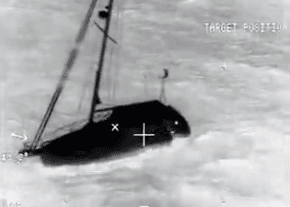Another fascinating Coast Guard video (watch below) as a CG aircrew and a rescue swimmer pick up two sailors 25 miles offshore after there motorsailing vessel experienced flooding, lack of power and steering problems. A key point in making this recovery go smoothly was how effectively the two mariners in distress used their marine VHF to communicate with the MH-60 Jawhawk helicopter. A cell phone is not going to get the job done in this type of situation. Coast Guard helicopters don't have their cell phone number painted on the fuselage!
From the press release: The Coast Guard rescued two men Wednesday after their sailboat, the Andante II, became disabled approximately 25 miles east of Cape Lookout, N.C., at 5:34 p.m. Rescued were Jim Southward and Pat Schoenberger. Southward and Schoenderger notified Coast Guard Sector North Carolina watchstanders that they lost engine power, steering and were taking on water.
Watchstanders deployed an aircrew aboard an MH-60 Jayhawk helicopter from Coast Guard Air Station Elizabeth City, N.C. When the Jayhawk arrived on scene, the two men jumped into the water and swam away from their sailboat, allowing the Coast Guard crew to hoist the men while avoiding the hazard of the 41-foot sailboat’s mast. “Being able to talk directly to the two sailors on marine 16 removed a lot of their uncertainty and kept them engaged through the rescue process,” said Lt. Jenny Fields, the helicopter pilot who flew during the rescue. “We kept them updated of our position and our progress in devising a way to get them safely off their vessel and into the helo. The sailor’s radio discipline and effective communication with the Coast Guard throughout the day played a huge role in their rescue.”
The men were hoisted into the helicopter and taken to the air station. There are no reports of injuries.

